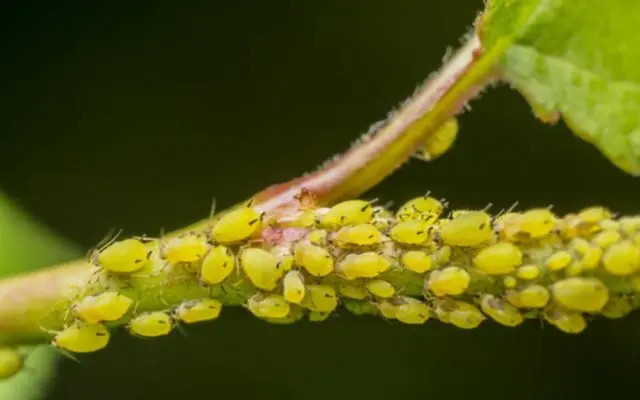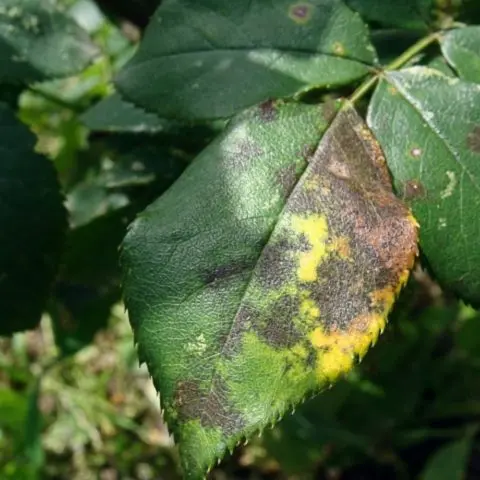Contents
Rose Jasmine is a profusely flowering variety of culture with a pleasant rich aroma. But this is not all the advantages of this species. Popular with gardeners around the world due to high frost resistance and unpretentious care. Climbing rose Kordesa Jasmine is ideal for vertical gardening, which allows you to create decorative columns, floral arches and decorate building facades. In order for the shrub to annually please with numerous fragrant flowers, it is necessary to create favorable conditions for it.
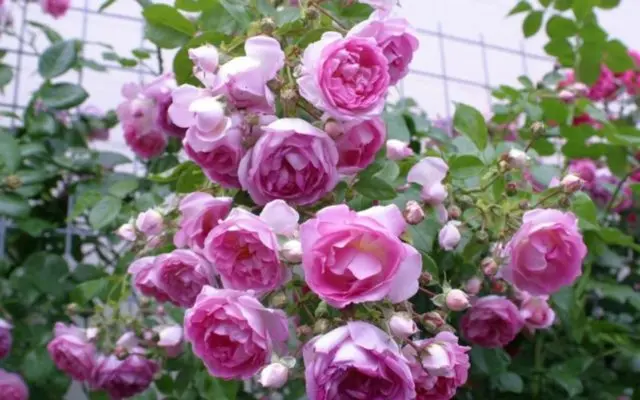
Rose Jasmine – re-blooming variety
History of breeding
Park rose Jasmine was bred in one of the oldest nurseries in Europe – “W. Kordes Sohne”. The company was founded by the former sailor Wilhelm Kordes in 1887, when he started growing and selling roses. Over time, the idea arose of breeding their own varieties.
Rose Kordesa Jasmine was bred in 2005 in Germany. This hybrid variety was obtained by crossing the seedling with the centenaire de Lourdes scrub. This species is one of the representatives of a whole group of garden roses under the common name Kordesii. He, like other varieties from this series, has passed severe tests, and confirmed his characteristics, for which he was awarded the ADR mark. It means that the rose has high decorative qualities, lush flowering and high resistance to adverse conditions.
Description of the Jasmine climbing rose and characteristics
Rose Jasmine is a perennial, well-branched, spreading shrub. Its height reaches from 1,5 to 3,0 m, depending on the region of cultivation. The diameter of an adult plant is 1,0-1,2 m.
This variety is a climber. This means that the shoots of the Jasmine rose have the ability to climb to a certain height, but at the same time remain stiff and not very flexible. In view of this, the shrub easily withstands the load during the flowering period.
Young branches are bright green with a reddish tint on the sunny side. But as they grow older, the bark noticeably fades and acquires a brownish tint. On the shoots there are frequent spikes of medium size, in the form of a slightly curved hook. The branches of the Jasmine rose are strongly leafy. Plates of a standard form. They have a dark green saturated color with a shiny surface, which is a confirmation of increased resistance to fungal diseases.
Important! Jasmine rose seedling grows to the size of an adult bush in the second year after planting.
This variety of culture has 2 waves of flowering per season. For the first time, the Jasmine rose forms numerous buds at the end of May. Initially, the flowers have a rich lavender-pink hue, but when fully opened, the outer petals become lighter and only in the center remains a bright color. The first flowering of the Jasmine rose is abundant and lasts up to 1,5 months, depending on weather conditions.
The buds are formed on the tops of the shoots and are collected in inflorescences of 8-14 pieces in one. For the second time in a season, the Jasmine rose blooms closer to autumn, namely at the end of August. But the flowers are already much less in this period. Buds are already formed only on young shoots of the current year. But this does not reduce the decorativeness of the variety, since individual flower brushes in combination with glossy dark green foliage look very impressive. Repeatedly this period lasts about 2-3 weeks. The flowers of the Jasmine variety rose are terry, consisting of 50-60 petals, cupped. As they bloom, they flatten, and the center with stamens is exposed.

The flowers of the Jasmine rose are quite large, their diameter reaches 6-8 cm.
This variety has a rich, pleasant aroma that combines notes of lime, apple, vanilla and honey. For this, the Jasmine rose was awarded a prize in 2007 in the Knight competition (France). The smell of flowers in her intensifies at noon and in the evening.
Frost resistance of the climbing large-flowered rose Jasmina
This variety of culture shows resistance to low temperatures. He is not afraid of frosts down to -23 degrees. But since the shrub blooms on last year’s shoots and the current year, it is necessary to cover the bushes for the winter so that they do not freeze.
The root system of the Jasmine rose is mainly located in the upper layers of the soil and extends almost horizontally from the neck. So that it does not suffer in a cold snowless winter, it is also recommended to cover the soil at the base of the rose with mulch.
Advantages and disadvantages of the variety
Park rose Jasmine (Jasmina) has a number of advantages that distinguishes it from others. But, this variety also has disadvantages that must be considered. To get a complete picture, you need to study all the features.

During the heat period, the flowers of the Jasmine rose quickly bloom and crumble.
The main advantages:
- abundant, long flowering;
- tall, spreading bushes;
- pleasant rich aroma;
- unpretentiousness in care;
- high frost resistance;
- increased immunity to fungal diseases.
Disadvantages:
- in rainy weather, flowers lose their decorative effect;
- does not tolerate stagnant moisture in the soil;
- requires sufficient free space.
Methods of reproduction
To obtain young seedlings of Jasmine roses, the cutting method is used. It allows you to save all the varietal characteristics of the mother bush. To do this, after the first flowering, cut a young lignified shoot into pieces with 2-3 internodes. Then completely remove the lower leaves, leaving only the upper ones to preserve sap flow in the tissues.
The lower cut of the cutting must be made at an angle of 45 degrees, and then powdered with any root former, planted in moist soil. To create favorable conditions, the cuttings must be covered with transparent caps.
Cultivation and care
This variety shows high decorativeness when planted in a sunny place and in partial shade. At the same time, it is important that the site is protected from drafts, and the groundwater level is at least 1,0 m. Rose Jasmine prefers fertile soil with a low level of acidity. But it is also permissible to plant it in clay and sandy soil, if peat and humus are first introduced.
Jasmine rose belongs to the category of varieties that do not tolerate prolonged drought. Therefore, in the absence of rain, it should be regularly watered 1-2 times a week with wetting the soil up to 20 cm. To do this, use settled water with a temperature of + 18- + 20 degrees.
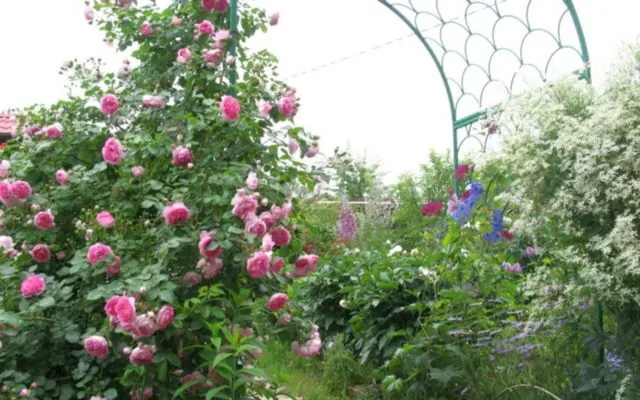
You need to water in the evening so that the rose can recuperate overnight
The shrub should be fed three times per season. The first time this must be done in the spring during the active growing season. To do this, you can use urea 30 g per bucket or chicken manure in a ratio of 1:15. The second and third times should be top dressing during the formation of buds and flowering. During this period, superphosphate 40 g and potassium sulfate 20 g per 10 liters of water should be used.
Throughout the season, you need to constantly loosen the soil at the base of the shrub and remove weeds in a timely manner. This will preserve nutrients and improve air access to the roots of the rose. During a period of prolonged drought, in order to prevent excessive evaporation of moisture from the soil, it is necessary to lay pine bark mulch 3 cm thick in the root circle. Do not use fallen leaves and humus, as this can lead to the defeat of the Jasmine rose by fungal diseases.
This variety does not need shaping pruning. Therefore, every spring, you only need to remove frozen shoots, as well as broken and damaged ones. In addition, it is necessary to shorten all branches to 5 buds before they have time to bloom.
At the onset of the first autumn frosts, the Jasmine rose should be removed from the support and the shoots bent down to the ground. After that, it is necessary to pour the earth at the base of the bush and compact it, and lay a layer of straw on top. At the end, completely cover the rose with agrofibre, fix it so that it does not blow away with the wind.
Pests and diseases
Rose Jasmine, like all park species, has a high natural immunity. But if the growing conditions do not match, its stability decreases.
Possible difficulties:
- aphid. This small pest feeds on the juice of the leaves and shoots of the rose, which significantly weakens the bush. Aphids are easy to detect, as they form numerous colonies that can be seen on the back of the plates and on the apical processes. For destruction, “Confidor Extra” should be used.

- black spotb. This disease develops during cool rainy weather. Initially, dark dots appear on the leaves, and then they increase in size. As a result, premature leaf fall occurs. Bordeaux mixture should be used for prevention and treatment.

- Mučnistaâ rosa. This disease progresses in hot weather with high humidity. It can be identified by a white coating on the leaves, which subsequently acquires a dirty gray tint. As a result, this leads to the wilting of the plates. For treatment, it is necessary to use “Skor”.

Application in landscape design
This variety is ideal for vertical gardening. You can use the Jasmine rose in the garden both in single and group compositions, as well as to decorate arbors, arches and the main entrance to the house. Its beauty can be successfully emphasized by conifers and decorative deciduous shrubs. Also, this rose can be used to create complex multi-level flower beds, placing low-growing types of culture in the center and on the sides. The main thing is to take into account the compatibility of shades.
The Jasmine variety rose is also suitable for creating “living” flowering hedges, since in many regions of the country it can be grown without shelter for the winter.
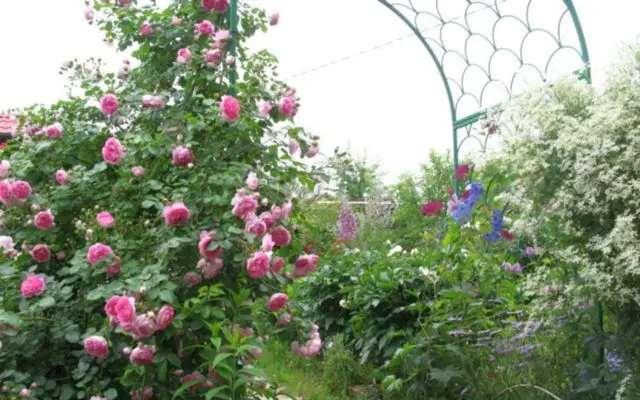
When planted in the shade, the decorativeness of the variety is reduced.
Conclusion
Rose Jasmine is a spectacular variety of culture that, with minimal care, can delight with its lush flowering every year. At the same time, the shrub can grow in one place for more than a dozen years, while maintaining its decorative effect. But when grown in regions with a harsh climate, it is necessary to completely cover the branches of the shrub so that they do not freeze out.










